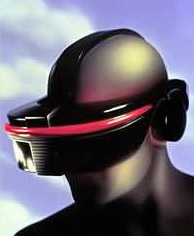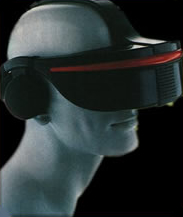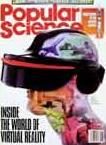As we detailed two years ago in our feature Sega VR: Great Idea or Wishful Thinking?, there was a great deal of controversy surrounding Sega’s attempt to create a virtual reality helmet for the Genesis console. Hyped in several  magazines, including a two-page spread in Sega Visions Magazine, the helmet was going to be the next big peripheral that would change the face of gaming. Instead, it was another piece of vaporware that never made it past the prototype stage, with Sega abruptly ending development in 1994. What happened? Why was the VR technology, which had been so promising, suddenly been killed?
magazines, including a two-page spread in Sega Visions Magazine, the helmet was going to be the next big peripheral that would change the face of gaming. Instead, it was another piece of vaporware that never made it past the prototype stage, with Sega abruptly ending development in 1994. What happened? Why was the VR technology, which had been so promising, suddenly been killed?
That depends on whom you ask. Sega’s official story is that it discontinued work on the VR Helmet due to the technology’s tendency to hurt users during movement. Others, including some of those who actually worked on the project, believe that it had more to do with money than anything else. Sega-16 recently spoke to an VR system engineer about his experience and what he felt caused its unexpected demise. Employed at Ono Sendai, the company in charge of development of the 3-DOF (degrees of freedom) tracker used in the helmet, he had many interesting anecdotes about what really went on behind the scenes.
Sega-16: What how did you come to get involved with Ono Sendai, and what exactly was your role regarding the Sega VR helmet?
Bandit: First, I am a systems engineer with about 30 years experience. I am also a science fiction fan (since the age of seven) and had read Neuromancer and its sequels. I had known Marc deGroot for several years, and we would chat on a regular basis. I had married and moved to Olympia WA for my wife – she was finishing a degree. I knew Marc (Pesce) was in San Francisco, and had worked for Jaron Lanier at VPL Research (the first company to sell VR equipment). We had many conversations on VR, and I had researched it on my own. Marc and Mike Donahue had gone up to Seattle for a VR conference or meeting at the UW HITLab. They stopped by our apartment to crash before driving south.
Well, I had sold some stock and I was a bit flush. I knew he had joined with Mark Pesce and Michael Donahue at Ono-Sendai. So, I took the Green Tortoise bus down to meet the guys, with thoughts of investing. In the first meeting, as we waved hands, shouted, chatted and generally talked VR, they looked at me and asked if I was interviewing. I asked if they were looking for folks. This ended up with me commuting on the Green Tortoise bus for a couple of months, then moving my family down to San Francisco.
Ono-Sendai was in the garage of the Victorian at 332 sixth street where Pesce, Donahue, and a couple of other folks lived. Marc and I had our own apartments, Rosey (office manager and artist) had a flat, and Dan (Art director) lived in the house. The hardware guy was Michael Perry, also renowned for his Forth83 implementation. Our goal was to create an entire VR system – HMD (head mounted display), software, everything. We made a number of prototypes, tearing video cams apart for the LCDs. I remember one night watching Michael Perry using Forth and a home-grown jig to determine the LCD parameters. It was a great feat of hacking.
I worked on a video game – basic shooter at tanks, limited field. I had something pretty good after two months, which included learning graphics. We put this in the headmount and used a joystick. Pesce took a forth board and a Radio Shack electronic compass and found the quadrature output. He then created a simple interface to it. This was the start of the Sega tracker. This was roughly Oct 1992. Donahue had set up a meeting with Sega to show the tracker. I built a foamcore box, with power and interface cable out of it, and we stuck the hacked up compass into it. We glued the edges and put Ono-Sendai stickers on them so we could detect intrusion. Pesce made a simple app on his powerbook to take the quad output and spin a ball/disk.
They (Sega) came back very happy – Sega liked us. We got some cash for a next-gen version. What I cannot remember is which of the units we left with Sega – the first or the next-gen. Sega had been talking to a couple of other groups for this project. It seems we were the only ones who could do what they needed (at the price point?) and even though we left the box with Sega, they could not figure out how we did it.
The tracking was the part Ono-Sendai was involved in, nothing else. I did most of the engineering (software, calibration, mechanical). Michael Perry did the hardware design.The next-gen was a simple PCB with driver hardware that attached to a NMI micro board running Forth. I called Radio Shack and was able to buy a bunch of compass coils for a couple of bucks each. We put the coil into a small project box and had ribbon cable running to the PCB/NMI electronics. I built a box out of plastic sheet, put a DB9 and power connector on one end, and sealed it up. I think this is the unit we let Sega play with.
We signed the contract with Sega shortly after that. I happened to be able to pick up the check – $250K if I remember right. The most money I had ever seen. I have a background in mission-critical systems. I had applied these techniques to my demo, and it never crashed during any demo. After a while of VR demos, the folks we were courting would deliberately try to crash the demo. They got pissed when they could not crash mine. The Japanese folks may have tried to crash it, but they never said anything about it. The only person I ever got to crash it was my then-two year-old son.
We moved into the “office” Jan 1992 – above the “almost out of date” store in SOMA. (I cannot remember the name of the store, but it has a rainbow as logo. We were in the old corporate offices.) It was right by the 101 raised exit – we could see the Dolby Labs easily. WE started building gen 3. We had a yaw sensor – the compass is a fluxgate magnetometer. However, we needed a pitch/roll sensor. There is a phenomena with fluxgate magnetometers. If you point one at North, then tilt it, the numbers still point North. But if you point one 45° off north and tilt, the numbers tilt towards North or East/West ( I cannot remember the bias). You need to measure pitch/roll to compensate this effect. We found a guy who had a sensor, cheap. It was two concentric plastic spheres. The inner sphere is clear, and filled halfway with castor oil. The outer sphere is black, with holes drilled in it for IR LEDs and optotransistor. The first model had one IR LED and four optotransistors, and we switched this around, because LEDs have much better matching tolerances than optotransitors.
The project was canceled and we did not have a good backup plan.We had a friend who invested $200K (I invested $12K early on), but we chewed through that before Sega. Ono-Sendai failed for the two standard reasons: lack of money and people flaked. I gotta say, people flaked big time. deGroot rarely showed, Pesce was fired by Donahue just after we moved into real offices, Perry saw the signs and started looking for other ventures. This says nothing about our marketing guy, who I think was trying, the sales guys who could sell ice to eskimos, or the guy we hired for marketing before we learned he had just gotten out of jail for fraud.The upshot is Ono-Sendai was out of business by October, 1993.
Sega-16: What was your initial impression when you first heard about it?
 Bandit: Cool – I thought it was great that a game company was willing to do it. I thought that this would really kick start the process, once enough units got out there and hackers started on it. Of course, certain tech info might just leak out to help the hackers :^) I also thought that this was it – we were on the road.
Bandit: Cool – I thought it was great that a game company was willing to do it. I thought that this would really kick start the process, once enough units got out there and hackers started on it. Of course, certain tech info might just leak out to help the hackers :^) I also thought that this was it – we were on the road.
Sega-16: VR technology in the early 1990s wasn’t really considered feasible for home consoles. When Sega contacted Ono Sendai about doing the VR helmet, did it seem like something that could actually have been brought to market in the manner that was proposed?
Bandit: We thought they could create the system, esp after the HMDs showed up. Also – my understanding is we contacted Sega first on the tracker. We knew Sega was up to something. However, I lived in the garage and was not privy to some of the machinations.
Sega-16: Had it been completed, do you think the VR helmet could have actually been as groundbreaking as Sega had hoped it would be?
Bandit: Oh, yes – the hackers would have a field day with it. Just look at the Power Glove. You have to remember that an HMD was $10K+ This would have put the tech within the reach of the average garage VR guy (like me). It was the hot tech. The garage VR folks needed this piece to really make it boom. Everything else was in place – crude, but there. HMD’s were not, at least not in quantity.
Sega-16: What were some of the biggest hurdles you faced while working on the project?
Bandit: We had problems with the hardware. Perry was not around much, and it had a fair amount of analog voodoo – stuff he is great at, but I am not. People flaked – I was often the only one working on it. I am not trying to come across as bitter. However, a startup demands the dedication of all members, not just one or two. The biggest problem was Sega management, from my perspective (not that ours was spectacular). His name was Mark Johnson Williams.
Sega-16: Did you ever get to see any of the games that were in development? If so, what were they like?
Bandit: No – we never got a look. We would use Ren and Stimpy tapes (the sound guy roomed with the producer) if we need an NTSC source. We took a flying game (Star Wars?) and use the sensor as a demo input device to control the game. We only used the yaw for side to side and pitch for up/down. I remember we also just used to roll/pitch for the control, as an example of different mappings.
Sega-16: Sega reportedly halted the project due to users “hurting themselves.” Is this true? Was it really Sega’s doing or were there other factors involved?
Bandit: Mark Johnson Williams allowed the project to get behind. We were also struggling, and I am not sure we could have hit the price point of $5. Maybe $10, but not $5. Realistically, we did not have enough resources (time, money) for this scale of product. We should have been in full production June of 1993, if not earlier. We were still doing development at that time. Christmas 1994 was more realistic – we could have made that. The HMDs were still the laser-cured polymer cases – and Kopin could not have made enough LCDs. (Pretty sure Kopin was the LCD provider.)
The resolution on the HMD was pretty crappy. There is no way it was realistic enough to fool folks. QVGA at best – 256 x 320 or something similar. There is a danger with HMDs: the IPD (inter-pupular distance) must be properly set. IO Glasses gets around this by having a really big aperture (sp). Sega had a thumbwheel to adjust the IPD. Here is the danger: if the IPD for the LCDs are wider than the user IPD, you force the user’s eyes to look outward. This is the opposite of cross-eyed. This can really stress the weak muscles around the eyes, and can cause permanent damage in less than 30 minutes. What I heard was the Sega lawyers brought up the liability issue on the eye damage. That is the reason I heard the project was canceled. Take it with whatever block of salt you want.
One issue was frame rate. From 4-12 HZ you are in the “barfogenic” region[1] (that is a real technical term). They needed to keep the frame rate up to at least 15 HZ, and you can see flicker. It can cause a bad headache. Another issue is lag – between turning your head and the scene shifts with you. If the lag is past a certain point, and it does not take much, you will lose it. The ears and eyes must be in sync, or the body thinks it is poisoned and ejects from the nearest orifices, the same effect as being drunk.
There is also the “simulator effect.” Pilots who train in a simulator are not allowed to fly for a day or so, because there is enough differences between a simulator and reality to create a problem. I think they were concerned about kids walking into walls because you can in a VR. I did not consider this a problem, because kids are fairly quick on such things. What is a bigger problem is a driving game then driving for real just after – the reactions are different and the margin of error is much less :^)
Sega-16: It’s been rumored that Sega wasn’t exactly the best business partner to be involved with during the 16-bit era (as evidenced by its Nintendo-like licensing agreements to some 3rd party companies). Was this ever an issue while working on the VR helmet?
Bandit: Most of the machinations was not visible to me. I do think we should have had more money. Sega dropped us real quick.
Sega-16: Do you think there’s still room for this type of technology in gaming today?
Bandit: Yes! Take the Xbox controller you pitch/roll – that is a form of this technology. IO Glasses are hanging in there – and gamers are one of their customer bases.
When lasers first came out, it took the better part of 20 years before applications really started to take off.
 Realistically, it’s been 15 years for VR (it was underground in the 80’s). I can tell you the moment VR started as an industry. Not VPL – that was all military and hidden. It was the talk by Tom Furness at the Nebula Awards dinner in San Francisco in 1989 to all the science fiction writers – VR started being in stories within 18 months (yes, VR goes back decades in science fiction, but not the name. See Way Station by Clfford D. Simak). Neuromancer in 1980 started folks thinking about it, but even in the early ’90s at Meckler you could get everybody, worldwide, in VR into one large room.
Realistically, it’s been 15 years for VR (it was underground in the 80’s). I can tell you the moment VR started as an industry. Not VPL – that was all military and hidden. It was the talk by Tom Furness at the Nebula Awards dinner in San Francisco in 1989 to all the science fiction writers – VR started being in stories within 18 months (yes, VR goes back decades in science fiction, but not the name. See Way Station by Clfford D. Simak). Neuromancer in 1980 started folks thinking about it, but even in the early ’90s at Meckler you could get everybody, worldwide, in VR into one large room.
My estimate then was it would take 10-15 years to start getting a clue on what we could do with this stuff.
I think we are just starting to get a clue. Yes, there are maybe a dozen good apps, like phobia therapy, but this is the tip of the iceberg. The big shared worlds are a form of VR – esp the kind that you can explore and modify as you want. The avatars are still kind of crude, but they are getting very realistic.
Sega-16 would like to thank “bandit” for his time and the information he’s shared on this much misunderstood part of Sega’s history.
[1].
Experience shows that VR viewers adjust to low-resolution monitors. The brain also accepts slow, jerky frame speed and much faster live action — 30 frames per second. But in between lies what Thomas P. Piantanida, principal scientist of SRI International’s Virtual Perception Program, calls the ”barfogenic zone” — from 4 to 12 frames per second. At that speed, the confusion between what the brain expects and what it sees can make viewers sick. Until computers can create complex worlds with live motion, Piantanida’s work suggests that it’s better to run crude displays faster than to run detailed displays in the barfogenic zone. Hamilton, Joan O.C. “Virtual Reality- How a Computer-Generated World Could Change the Real World. Businessweek. 4 Oct. 1992.

Recent Comments